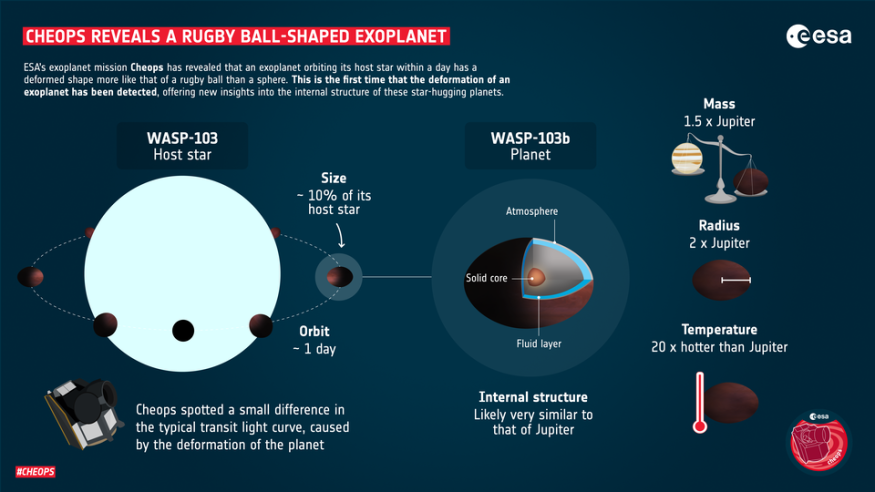A team of astronomers researching faraway exoplanets discovered one that appears to be shaped more like a football than a sphere with the help of European Space Agency's (ESA) exoplanet mission Cheops . The planet's form is thought to be created by the host star's powerful tidal forces.
WASP-103b is a planet identified in 2014, roughly 1,530 light-years from Earth. It revolves around its star in less than a day and is slightly more massive and 20 times hotter than Jupiter. This planet, however, is oblong, unlike our neighboring gas giant.
A team of experts detailed the findings of their study, titled "Detection of the tidal deformation of WASP-103b at 3 σ with CHEOPS," in the journal Astronomy & Astrophysics.

Inflated WASP-103b Planet
WASP-103b orbits its star WASP-103 at a distance of only 1.8 million miles away. In comparison, Earth is 93 million kilometers from the sun on average. The planet is so near to its star that it takes less than a day to complete an orbit around it. It's also humid, with temperatures hovering at 2204.44ºC (around 4,000ºF).
Astronomers have been drawn to the planet because of its twisted characteristics. According to Newsweek, WASP-103b is continually subjected to massive gravitational tides as it circles its star.
They had assumed that these tides would be powerful enough to change the shape of planets, but they had never been able to quantify how much this might happen until now.
A large team from numerous universities worldwide determined that WASP-103b had been distorted into a football shape by its star using fresh data from the European Satellite Agency's Characterising Exoplanets Satellite (CHEOPS) space observatory, as well as previous NASA data.
In a statement, study lead author Susana Barros said WASP-103b must be swollen due to its star's heating and other reasons. Barros, an astrophysicist at the Instituto de Astrofsica e Ciências do Espaço and the University of Porto in Portugal, added that a planet 1.5 times Jupiter's mass should be around the same size.
WASP-103b is a hot Jupiter, an exoplanet with many characteristics of a gas giant. The newly discovered planet isn't the first weirdly shaped hot Jupiter: WASP-121b, a football-shaped world, was discovered to be spewing heavy metals in 2019.
How CHEOPS Helped Experts Find This Inflation
CHEOPS was able to identify the planet's extremely distinctive light characteristics as it transited its home star. Astronomers were able to determine the exact tidal deformation using this information.
According to Futurism, this is the first time such an examination has been done via CHEOPS. Scientists anticipate that by watching for a longer period, they will confirm their findings and get a deeper understanding of the planet's underlying structure.
The researchers now expect that future studies by the James Webb Space Telescope, which was just launched, may provide further details about the unusual planet's deformation - as well as the rest of the cosmos.
RELATED ARTICLE : Super-Earth Rocky Planet TOI-270 B: What Makes It Unique Compared to Others in Our Solar System?
Check out more news and information on Space in Science Times.
© 2026 ScienceTimes.com All rights reserved. Do not reproduce without permission. The window to the world of Science Times.











